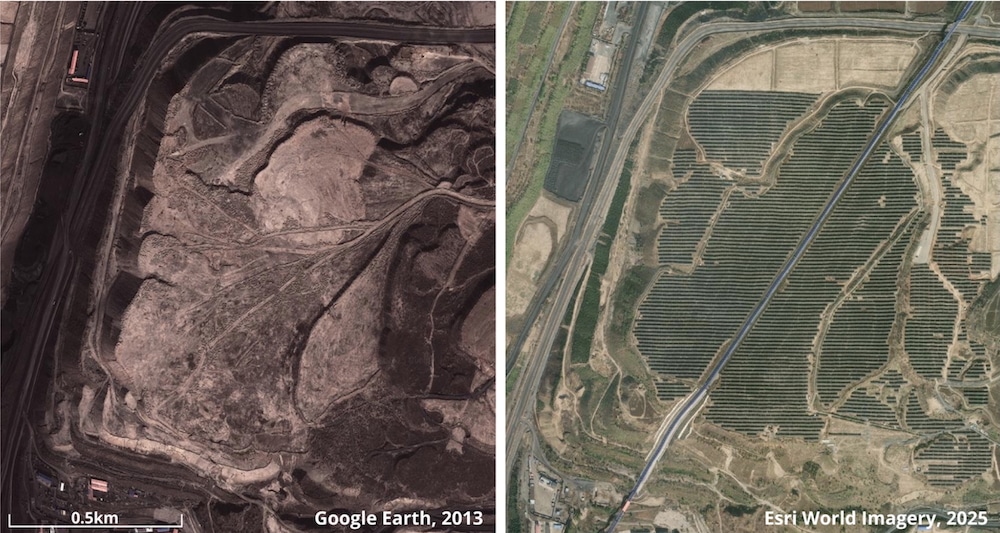This post was originally published on Eco Watch
Recently shuttered coal mines around the world can have new life as solar farms, potentially adding nearly 300 gigawatts (GW) of clean energy by 2030, a first-of-its-kind analysis by researchers from Global Energy Monitor (GEM) has found.
GEM’s Bright side of the mine report identified 312 surface coal mines that had been closed since 2020, as well as 134 that were likely to close by 2030. Together, these wastelands cover 2,250 square miles, reported The Guardian.
“Coal was once billed as the ‘buried sunshine’ of a prehistoric past. But the world has now entered an age of solar energy — a time when harnessing the sun has become more accessible, affordable, and environmentally sustainable than digging it up in fossil fuels,” a press release from GEM said.
Our new analysis finds that converting 446 coal mines could add nearly 300 GW of solar — equal to 15% of global capacity.
Most of this potential is concentrated in a few regions, highlighting where targeted action could deliver outsized clean energy gains.
globalenergymonitor.org/report/brigh…
— Global Energy Monitor (@globalenergymon.bsky.social) June 18, 2025 at 9:33 AM
The world installed a record nearly 600 GW of solar capacity last year, and over 2,000 GW of utility-scale solar projects are currently in development. But these projects require widespread land use, and developers often find it hard to find prime locations that are not off limits or already being used. But there are vast tracts of scarred land across the globe in the form of abandoned coal mines that can be repurposed.
Since 2020, GEM has conducted a global survey of shut-down surface coal mines and those with planned closures by the end of the decade. The first-time analysis showed that more than 300 of these mines could house roughly 103 GW of photovoltaic (PV) solar capacity, while large operations that are scheduled to close could host another 185 GW across 127 sites.
Because they are already cleared and grid-adjacent, these abandoned mines are prime locations for renewables.
“If these potential solar projects came to fruition, the world could build almost 300 GW of solar capacity on mined out lands by the end of 2030. Uptake on that scale is equal to 15% of the solar that has already been built globally and would add enough solar capacity to inch the world one step closer to tripling renewables before the end of the decade,” GEM said.
2013 and 2025 satellite images of part of the Pingshuo Mining Area, which houses two operating surface coal mines, in Shanxi Province, China. Solar under development on the degraded mining land is expected to generate 160 MW. Global Energy Monitor
Some of the transitional projects have already begun. New data from GEM on coal-to-solar projects shows that there are 90 operational conversions with 14 GW of capacity in China, and 46 additional projects with nine GW of capacity currently in the planning stages.
“The coal-to-solar transition offers a rare chance to repair the environmental hazards and eyesores of open pits,” GEM said. “Constructing solar on upheaved lands isn’t just land reclamation — it’s a chance to align land restoration, clean energy goals, and local job creation.”
Strip mining has turned former wildlife habitats into polluted wastelands stripped of their topsoil. But if the sites were converted to house solar energy plants, they would be able to help the planet by generating enough renewable energy to power a country the size of Germany, the report said.
“The legacy of coal is written into the land, but that legacy does not have to define the future. The coalmine to solar transition is underway, and this potential is ready to be unlocked in major coal producers like Australia, the U.S., Indonesia and India,” said Cheng Cheng Wu, project manager for GEM’s energy transition tracker, as The Guardian reported. “Repurposing mines for solar development offers a rare chance to bring together land restoration, local job creation, and clean energy deployment in a single strategy. With the right choices, the same ground that powered the industrial era can help power the climate solutions we now urgently need.”
The post Turning Shuttered Coal Mines Into Solar Plants Could Add 300 GW of Renewable Energy by 2030: Report appeared first on EcoWatch.





0 Comments